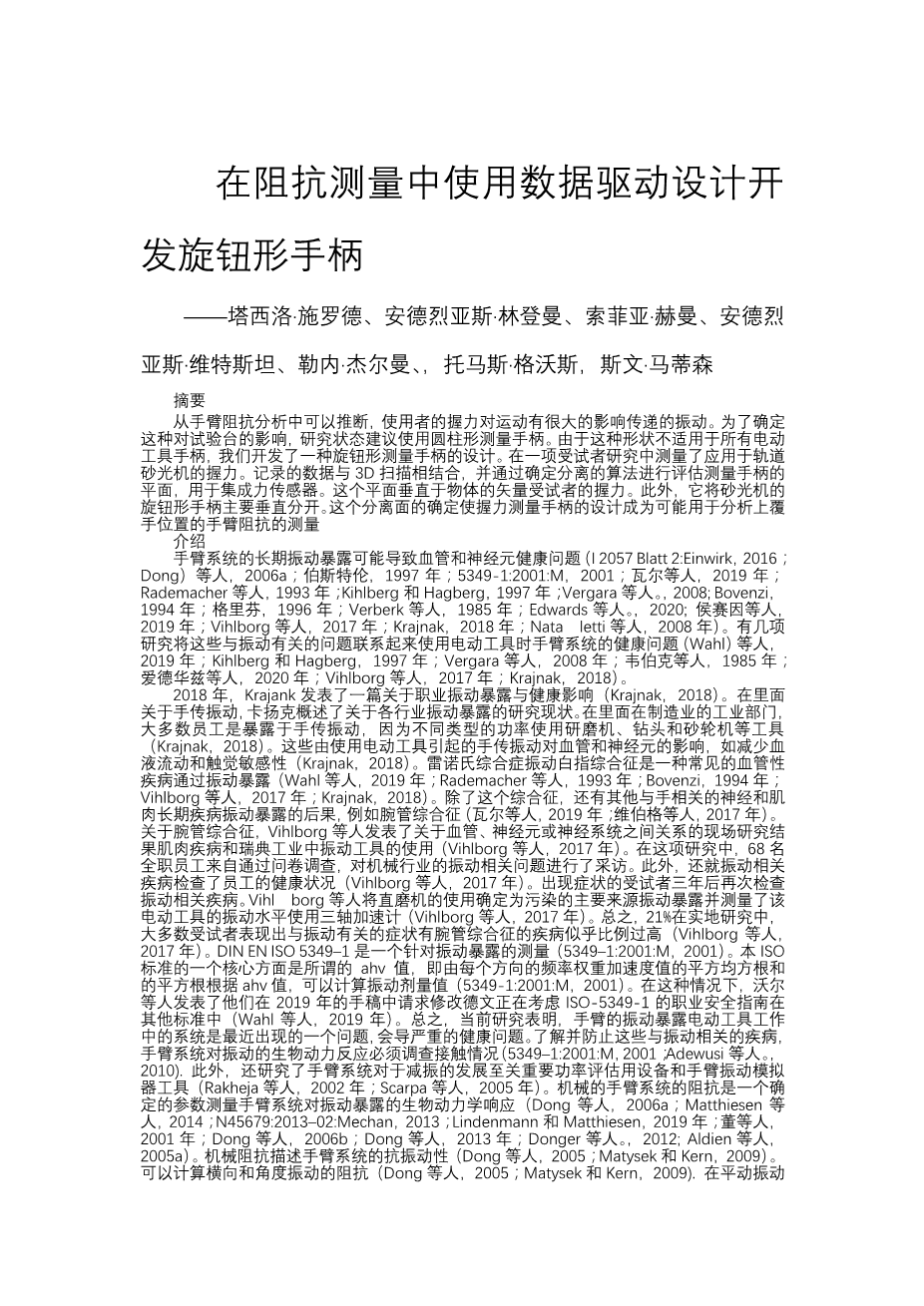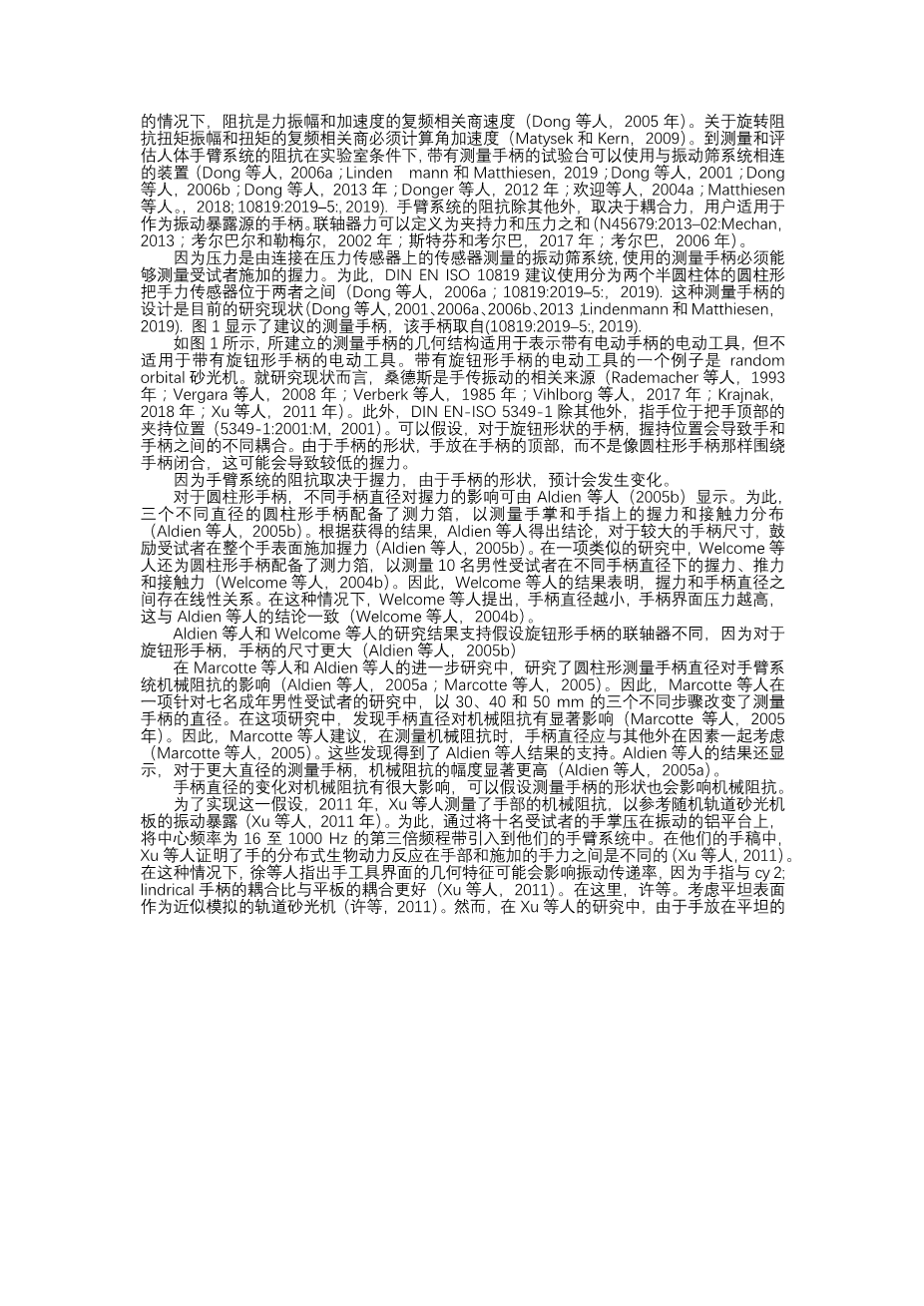在阻抗测量中使用数据驱动设计开发旋钮形手柄外文翻译资料
2023-04-04 15:49:51
Use of data-driven design for the development of knob-shaped handles in the context of impedance measurements
Abstract:
It can be inferred from hand-arm impedance analyses that the grip forces of users have a great influence on the transmitted vibrations. To determine this influence on test benches, the state of research suggests a cylindrical measuring handle. Since this shape is not suitable for all power tool handles, we develop a design for a knob- shaped measuring handle. The grip force applied to an orbital sander was measured in a test person study. The recorded data was combined with a 3D scan and evaluated by an algorithm which determined the separation plane of the measuring handle to integrate the force sensors. This plane is perpendicular to the vector of the subjectsrsquo; grip forces. Furthermore, it divides the knob-shaped handle of the sander primarily vertically. The determination of the separation plane enables the design of a knob-shaped measuring handle for grip force measurement to analyze the hand-arm impedance of an overlying hand position.
Introduction
The long-term vibration exposure of the hand-arm system can lead to vascular and neuronal health issues (Einwirk, 2016; Dong et al., 2006a; Burstrouml;m, 1997; 5349–1:2001: M, 2001; Wahl et al., 2019; Rademacher et al., 1993; Kihlberg and Hagberg, 1997; Vergara et al., 2008; Bovenzi, 1994; Griffin, 1996; Verberk et al., 1985; Edwards et al., 2020; Hussein et al., 2019; Vihlborg et al., 2017; Krajnak, 2018; Nata- letti et al., 2008). Several studies have linked these vibration-related health issues of the hand-arm system to the use of power tools (Wahl et al., 2019; Kihlberg and Hagberg, 1997; Vergara et al., 2008; Verberk et al., 1985; Edwards et al., 2020; Vihlborg et al., 2017; Krajnak, 2018). In 2018, Krajank published a review concerning the association between occupational vibration exposure and health effects (Krajnak, 2018). In terms of hand-transmitted vibrations, Karjank gave an overview of the state of research regarding vibration exposure in various industries. In the industrial sector of manufacturing, the majority of employees is exposed to hand-transmitted vibrations, since different types of power tools, such as grinders, drills, and sanders are used (Krajnak, 2018). These hand-transmitted vibrations caused by the use of power tools lead to vascular and neuronal effects like the reduction of the blood flow and tactile sensitivity (Krajnak, 2018). The Raynaud syndrome or so-called vibration white finger syndrome is one of the vascular diseases caused by vibration exposure (Wahl et al., 2019; Rademacher et al., 1993; Bovenzi, 1994; Vihlborg et al., 2017; Krajnak, 2018). Besides this syn- drome, there are other hand-related neuronal and muscular long-term consequences of vibration exposure, e.g. the carpal tunnel syndrome (Wahl et al., 2019; Vihlborg et al., 2017).
Concerning the carpal tunnel syndrome, Vihlborg et al. published the results of a field study on the association between vascular, neuronal, or muscular diseases and the use of vibrating tools in the Swedish industry (Vihlborg et al., 2017). In this study, 68 full-time employees from the mechanical industry were interviewed about vibration-related symp- toms using a questionnaire. In addition, the health status of the em- ployees was examined with regard to vibration-related diseases (Vihlborg et al., 2017). Subjects who showed symptoms of vibration-related diseases were examined again after three years. Vihl- borg et al. identified the use of straight grinders as the main source of vibration exposure and measured the vibration level of this power tool with a tri-axial accelerometer (Vihlborg et al., 2017). In summary, 21% of the subjects in the field study showed symptoms of vibration-related disorders, with carpal tunnel syndrome appearing to be overrepresented (Vihlborg et al., 2017). DIN EN ISO 5349–1 is an established standard for the measurement of vibration exposure (5349–1:2001: M, 2001). A central aspect of this ISO standard is the so-called ahv-value, which is represented by the square root of the sum of the squared RMS value of the frequency weight acceleration values from each direction.
Based on the ahv-value, the vibration dose value can be calculated (5349–1:2001: M, 2001). In this context, Wahl et al. published a manuscript in 2019 in which they plead for a revision of the German occupational safety guidelines under consideration of ISO-5349-1 among other standards (Wahl et al., 2019). In summary, the current state of research shows that the vibration exposure of the hand-arm system in the work of power tools is a recent problem and leads to serious health issues. To understand and prevent these vibration-related diseases, the biodynamic response of the hand-arm system to vibration exposure must be investigated (5349–1:2001: M, 2001; Adewusi et al., 2010). In addition, the investigation of the biodynamic responses of the hand-arm system is essential for the development of vibration damping devices and hand-arm vibration simulators for the assessment of power tools (Rakheja et al., 2002; Scarpa et al., 2005). The mechanical impedance of the hand-arm system is an established quantity for measuring the biodynamic responses of the hand-arm system to vibra- tion exposure (Dong et al., 2006a; Matthiesen et al., 2014; N 45679:2013–02: Mechan, 2013; Lindenmann and Matthiesen, 2019; Dong et al., 2001; Dong et al., 2006b; Dong et al., 2013; Donget al., 2012; Aldien et al., 2005a). The mechanical impedance describes theresistance of the hand-arm system against vibration (Dong et al., 2005; Matysek and Kern, 2009). The impedance can be calculated for trans- lational and angular vibrations (Dong et al., 2005; Matysek and Kern, 2009). In the case of translational vibrations, the impedance is the complex frequency-dependent quotient of the force amplitude and the velocity (Dong et al.,
剩余内容已隐藏,支付完成后下载完整资料


英语译文共 10 页,剩余内容已隐藏,支付完成后下载完整资料
资料编号:[590734],资料为PDF文档或Word文档,PDF文档可免费转换为Word




